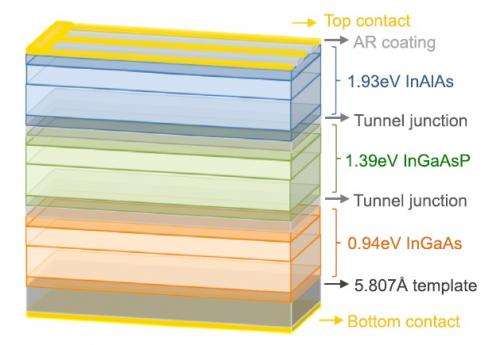February 20, 2013 feature
Multijunction solar cell could exceed 50% efficiency goal

(Phys.org)—Scientists have designed a new multijunction solar cell that, in simulations, can achieve an efficiency of 51.8%. This high performance exceeds the current goal of 50% efficiency in multijunction solar cell research as well as the current world record of 43.5% for a 3-junction solar cell.
The work was performed by a collaboration of researchers from the California Institute of Technology in Pasadena; the National Institute of Standards and Technology in Gaithersburg, Maryland; the University of Maryland in College Park; and Boeing-Spectrolab, Inc., in Sylmar, California. The team published a paper on their work in a recent issue of Applied Physics Letters.
As the researchers explain, multijunction solar cells are one of the most promising devices for efficiently converting sunlight into electricity. In multijunction solar cells, each junction or subcell absorbs and converts sunlight from a specific region of the spectrum. The subcells can be stacked on top of one another so that sunlight first strikes the highest bandgap subcell, which is tuned to light with the shortest wavelengths or highest energies. The longer wavelengths pass through the first subcell and strike the lower bandgap subcells.
This arrangement offers a significant advantage over single-junction solar cells, which have a maximum theoretical efficiency of only 34%. In theory, an "infinite-junction" solar cell has a maximum theoretical efficiency of almost 87%. But to approach this level, multijunction solar cells not only need multiple subcells, but optimal semiconductor materials for the subcells to provide a combination of band gaps that cover as much of the solar spectrum as possible.
To improve upon the current best multijunction solar cells, the researchers here focused on improving the current match between the different subcells, along with using a lattice-matched design. Both of these factors have previously limited multijunction solar cell efficiency.
"The lattice match corresponds to the matching between the crystal unit cells from the different subcells," lead author Marina Leite, an energy researcher at the National Institute of Standards and Technology, told Phys.org. "By using subcells that are lattice-matched, we can minimize dislocations and other crystal defects that can significantly affect the performance of the device. A current match is required for two-terminal tandem configurations because in this case a single current passes through all the subcells and the voltages are added; therefore, if one subcell has less photocurrent it will limit the current generated by the entire device. The current match is desired so that each individual subcell works at its own maximum power point of operation."
The researchers performed full-device simulations to investigate the solar cell's potential efficiency. For every layer in the modeling, they considered numerous factors, such as material composition, lattice constant, thickness, dielectric constant, electron affinity, band gap, effective conduction and valence band densities, electron and hole motilities, the doping concentration of shallow acceptors and donors, the thermal velocity of electrons and holes, the alloy density, Auger recombination for electrons and holes, direct band-to-band recombination, and how many photons with a specific wavelength are absorbed and reflected by each layer based on its dielectric properties.
Accounting for all these factors, the simulations showed that the 3-junction design could achieve an efficiency of 51.8% under 100-suns illumination, a great improvement over the current best 43.5% efficiency under 418-suns illumination. All three subcells in the new design had a maximum external quantum efficiency of 80% and absorbed light from a wide range of the spectrum.
"The multijunction solar cells are tested under different numbers of suns because they are often used in concentrator photovoltaic systems, which allow us to reduce the size or number of cells needed," Leite explained. "These strategies tolerate the use of more expensive semiconductor materials, which would otherwise be cost-prohibitive. The results can certainly be compared with each other, as long as the illumination sources are well calibrated."
The researchers also built a proof-of-principle solar cell with an equivalent design, which they fabricated on an indium phosphide (InP) substrate. The solar cell was not optimized, so its efficiency was far from the theoretical prediction, but the results nevertheless demonstrated the capability of experimentally realizing the design. The scientists predict that, with further improvements, this equivalent 3-junction solar cell could have a practical efficiency of around 20% under 1-sun illumination.
"[The fabricated solar cell] presents a poor current match but demonstrates our capability of growing high quality semiconductor compounds with an extremely low density of defects and stoichiometry very close to what is required for the optimized design," Leite said. "The bandgap-optimized design is formed by the same class of alloys, and has a great current match. So, upon optimization of anti-reflection coatings and other design parameters, the simulations indicate that one can reach greater than 50% under concentrated sunlight."
In addition to an optimized anti-reflection coating, some of the other improvements may involve adding window and back surface layers to reduce loss and thickening the lower two subcells to absorb long wavelength light more completely.
"I am very excited about our initial results concerning a bandgap-optimized design," Leite said. "In the near future I plan to work on the integration of the optimized design into the single crystal template in order to fabricate a first monolithic (1.93 eV)InAlAs/(1.39 eV) InGaAsP/(0.94 eV)InGaAs solar cell. Simultaneously, we are looking into anti-reflection coating options for the InAlAs top subcell, which will require an oxygen-free material or the combination of an oxide and a sulfide as a protective layer."
More information: Marina S. Leite, et al. "Towards an optimized all lattice-matched InAlAs/InGaAsP/InGaAs multijunction solar cell with efficiency >50%." Applied Physics Letters 102, 033901 (2013)
Journal information: Applied Physics Letters
Copyright 2013 Phys.org
All rights reserved. This material may not be published, broadcast, rewritten or redistributed in whole or part without the express written permission of Phys.org.




















